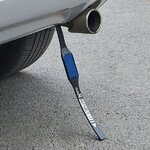T
treez
Guest
Hello
We are due to start work on a hospital robot…. “Hospitabot”. It’s a wheeled robot which goes round the hospital and can pick up parcels and then carry them and then deliver them to other parts of the hospital.
It also has radio receivers on it to give it specific commands when needed.
We don’t yet know the full spec, but we know enough to have grave concerns. Please confirm or refute our concerns?.......................
I am told the power is that given by its 24V, 20Ah battery.
All of its electric motors are Brushed Motors. We are also told that there is a noise problem with its comms system. Can you confirm that Brushed DC motors are a poor choice here, and a swap to BLDCs is in order? …. because all the electronics and comms and motors are packed tightly together, and as is surely known to all, brush noise is very aggressive.
There are offtheshelf SMPS’s on the robot, eg the JTH1524S15 for example….(and others of the same family)
JTH1524S15 24VIN 15VOUT, 15W DCDC module
https://www.xppower.com/portals/0/pdfs/SF_JTH.pdf
They have told us that the power supplies are causing noise problems with the comms systems.
Would you agree that these type of DCDC modules are optimised for Thermal performance and Efficiency…not for EMC? Do you agree that they probably switch the FETs on superfast, resulting in super high dv/dt and resultant noise issues?
Also, maybe the underside of these DCDC modules is not metal shielded? , and so maybe the underside can output noise which can couple to nearby electronics and cables?
In fact, would you agree that when electronics is packed tightly together like in this “Hospitabot”, it is often better to NOT use offtheshelf SMPS modules?, ……but instead, to use custom designed SMPS’s, with relatively high value FET gate resistors so as to damp the V(ds) switching transitions (lessen the dv/dt). This will reduce noise issues.
They are suspicious that the Hospitabot’s cable looms have not been routed correctly, and not been made correctly, and are picking up noise.
Also, the above JTH1524S15 power module has a recommended input filter as in the attached. If Vin = 24V gets hot plugged into this module, then, its input will ring up to 48V, and that will damage the module. Would you agree with this? (PDF schem and LTspice sim attached of input filter)
We are due to start work on a hospital robot…. “Hospitabot”. It’s a wheeled robot which goes round the hospital and can pick up parcels and then carry them and then deliver them to other parts of the hospital.
It also has radio receivers on it to give it specific commands when needed.
We don’t yet know the full spec, but we know enough to have grave concerns. Please confirm or refute our concerns?.......................
I am told the power is that given by its 24V, 20Ah battery.
All of its electric motors are Brushed Motors. We are also told that there is a noise problem with its comms system. Can you confirm that Brushed DC motors are a poor choice here, and a swap to BLDCs is in order? …. because all the electronics and comms and motors are packed tightly together, and as is surely known to all, brush noise is very aggressive.
There are offtheshelf SMPS’s on the robot, eg the JTH1524S15 for example….(and others of the same family)
JTH1524S15 24VIN 15VOUT, 15W DCDC module
https://www.xppower.com/portals/0/pdfs/SF_JTH.pdf
They have told us that the power supplies are causing noise problems with the comms systems.
Would you agree that these type of DCDC modules are optimised for Thermal performance and Efficiency…not for EMC? Do you agree that they probably switch the FETs on superfast, resulting in super high dv/dt and resultant noise issues?
Also, maybe the underside of these DCDC modules is not metal shielded? , and so maybe the underside can output noise which can couple to nearby electronics and cables?
In fact, would you agree that when electronics is packed tightly together like in this “Hospitabot”, it is often better to NOT use offtheshelf SMPS modules?, ……but instead, to use custom designed SMPS’s, with relatively high value FET gate resistors so as to damp the V(ds) switching transitions (lessen the dv/dt). This will reduce noise issues.
They are suspicious that the Hospitabot’s cable looms have not been routed correctly, and not been made correctly, and are picking up noise.
Also, the above JTH1524S15 power module has a recommended input filter as in the attached. If Vin = 24V gets hot plugged into this module, then, its input will ring up to 48V, and that will damage the module. Would you agree with this? (PDF schem and LTspice sim attached of input filter)

